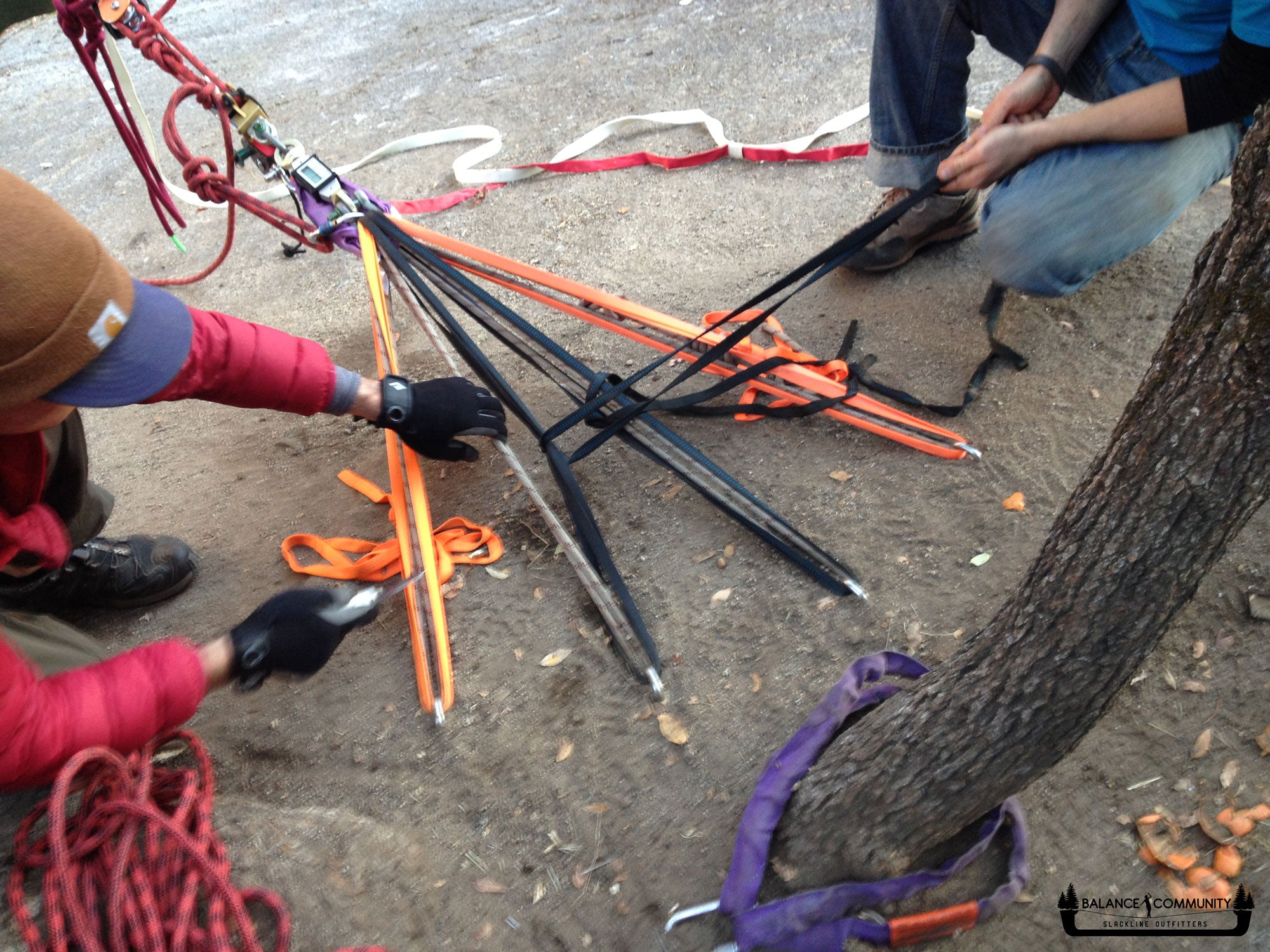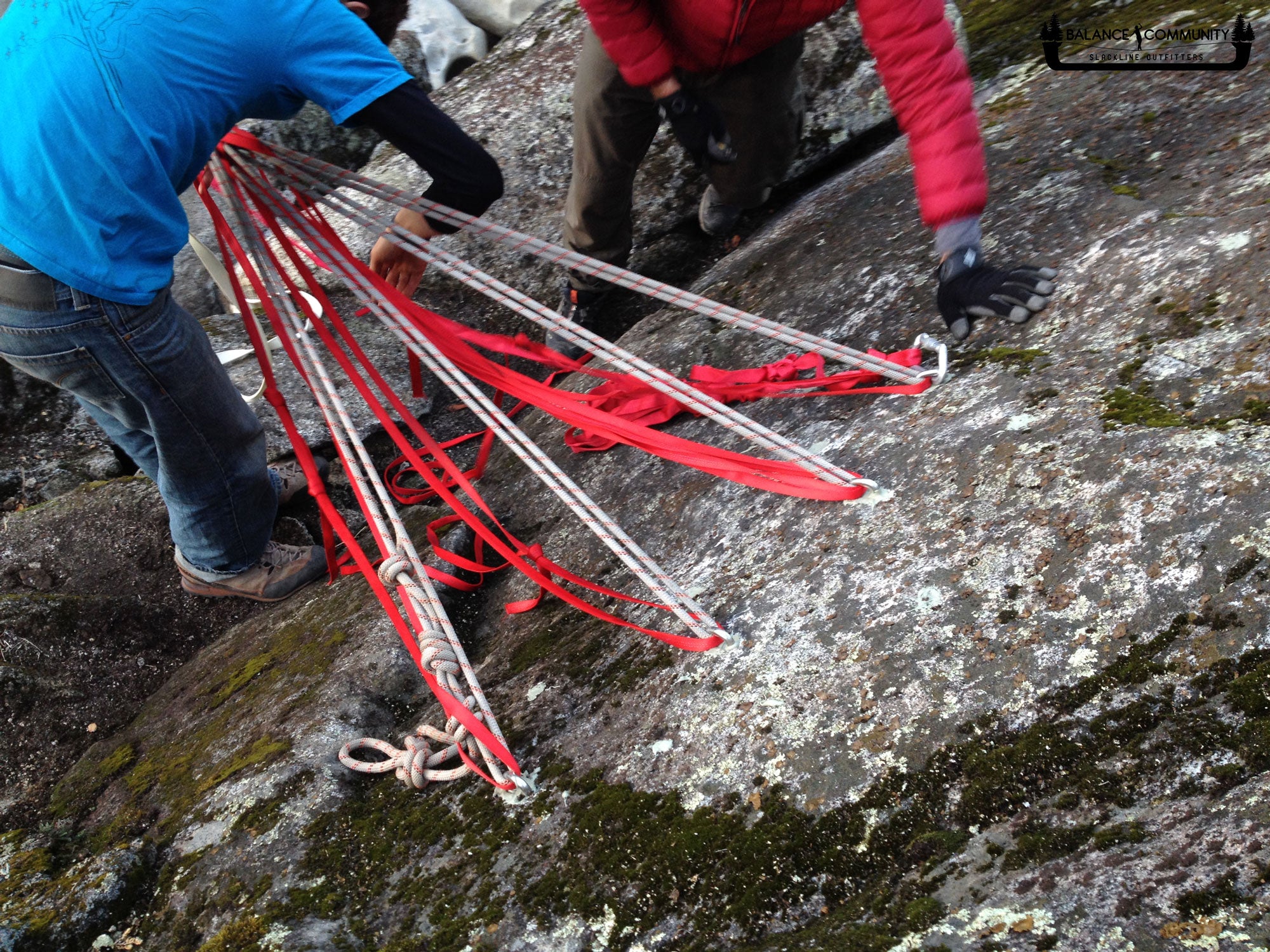You have no items in your shopping cart.
0
You have no items in your shopping cart.
Over the past several years I have been constantly optimizing my highline setups to make them lighter and easier to rig, while maintaining the redundancy and strength required to stay safe on a highline. Recently I have begun using static rope as my main highline anchor in combination with short lengths of tubular webbing tied between each bolt individually to prevent any sort of extension in the anchor if the static rope were to fail. Since adopting this method, I have been curious as to what would happen if the static rope were to fail and the tubular webbing strips were to be loaded. So, at a recent highline at CRG, we tested this thought.
First I will explain the type of highline anchor we were using. Then I will describe the line we tested this on. Lastly, I will describe the process of cutting the anchor.
On either side of the highline there are 4 glue-in bolts from Fixe Hardware. These glue-in bolts have eyes which are large enough to accommodate a static rope passing through them with additional room. Because I used static rope for my anchor, this allowed me to avoid the use of any hardware for the anchor (which decreased the weight significantly). To build the anchor, I took a piece of 10.5mm static rope that was about 30 feet long and threaded one end through all 4 glue-in bolts. I then proceeded to tie the ends of the rope together with a triple fisherman's knot. I then proceeded to build a Sliding-X Anchor making sure that the triple fisherman's knot was located on an outside leg (likely to have the least force on it). At the master point of this anchor I connected both my mainline and backup line using offset Alpine WebLocks, as seen in the picture below.

Having just the static rope sliding-x would not give me full redundancy because if any one of the strands of the rope were to be cut or fail, the entire anchor would fail. To avoid this situation, I have decided to go with individually backing up each bolt separately. To do this, I take a 20 foot length of 11/16" Slack-Spec Tubular and wrap it between the master point and a single bolt 2 times, then connect the ends with a waterknot. I do this for all 4 bolts. This sort of backup serves two purposes: as a backup for the main anchor and as extension prevention if a single bolt were to fail. In the case that a bolt were to fail, these backup slings would prevent the master point from extending out, thus shockloading the remaining bolts. It's my favorite anchoring solution I have found so far and would highly recommend it to other highliners out there.

The highline that we had rigged was 240 feet long and about 80 feet high located at Cosumnes River Gorge. The mainline was a heavyweight nylon prototype webbing and the backup was a lightweight, high elongation nylon webbing. On the tensioning side we had a high frequency dynamometer in the system on the mainline only. With this we were able to log peak loads of the event. The standing tension throughout the day fluctuated from 500 lbf to 1,200 lbf. At the time of testing, the line was sitting at 830 lbf.
We did 3 cuts to test various methods and to ensure we were getting accurate results. The first cut was to a center leg on the 4 bolt anchor where all the backup slings were rigged tightly to limit extension as much as possible. The second cut was done with much looser backup slings to see how violent the extension would be in such a scenario. The third cut was to one of the backup slings that was loaded first to simulate a multifaceted failure.
The results are somewhat amusing. On the first cut we started with 830 lbf on the mainline before the cut. We cut the rope anchor and virtually nothing happened. The anchor did not move even a centimeter and the tension dropped 2 lbf. All the slings were loaded perfectly and the two rope ends where the cut was made basically did not even move.
The second cut was a bit more eventful. We cut the same leg on this anchor, but since the backup slings were rigged much looser, there was quite a bit of extension. The tightest of the legs was loaded first, but it was a seemingly small shockload to this sling. Since there were two wraps of webbing on every bolt, the strength is far beyond what is needed. The strength of the double-wrapped slings has been tested at 6,000 lbf with 9/16" climb-spec tubular. With 11/16" Slack-Spec Tubular, I am sure the strength would be somewhere near 7,000 lbf for each sling.
The third cut was made to this sling that was loaded on the second cut to simulate if that first loaded anchor were to fail during the extension. When it was cut, there was further extension as the other slings were not yet tight, but the severity of the shockload was very minimal. Only 2 of the remaining 3 slings were loaded as the third was rigged much looser.
On inspection of the dyno after the second 2 cuts, we settled at around 430 lbf with a peak force of 830 lbf (standing tension from the beginning). Even though the total extension was less than 2 feet, we lost almost 50% of the tension. I suspect that this tension would rise slowly back up to around 550 - 600 lbf as the fibers regained their elasticity.
This experiment has made me much more confident in this anchor style. I was always a bit unsure of what would happen if the main anchor were to fail on such an anchor, but now I know that even if the backup slings are rigged very loose, there would not be enough force to cause any sort of harm to the slings. However, even though the shockload was minimal when the slings were rigged loosely, I would still recommend always making them as tight as possible. I wouldn't make them tight enough that they are loaded when the line is tensioned, but just enough to make them not loose.
In the future I would like to see what happens where there is a load on the line when such a failure occurs. I would also like to capture peak loads of an extending anchor during a leash fall.
| Product | Price | Quantity | Options | |||||
|---|---|---|---|---|---|---|---|---|
| Features |
| Availability: |
| Price |
| Options |
| Actions |

← Older Post Newer Post →
0 comments